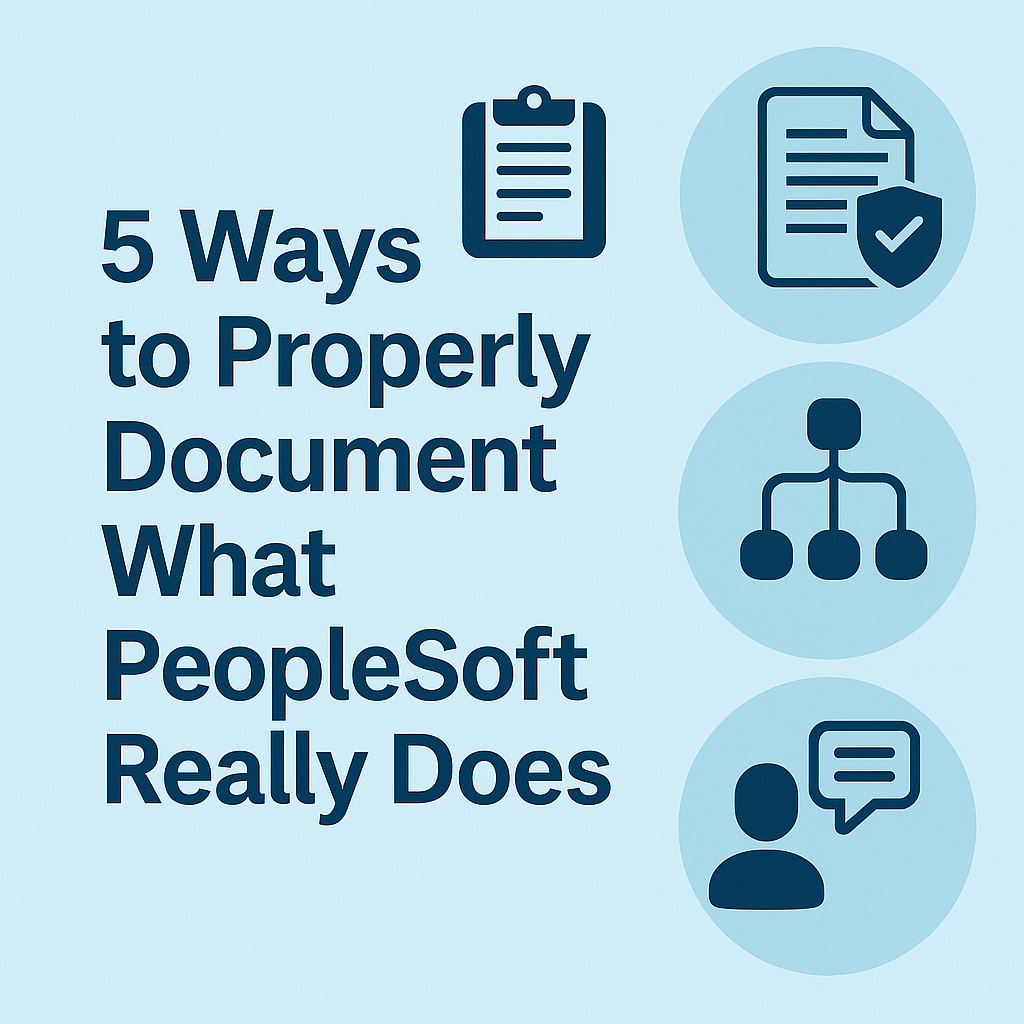5 Ways to Properly Document What PeopleSoft Really Does (Before You Even Think About SaaS)
Step 1 in the 10 Steps to Get Your PeopleSoft System Ready to Move to a SaaS Solution.
In my recent article, “10 Steps to Get Your PeopleSoft System Ready to Move to a SaaS Solution,” I laid out a roadmap for preparing your PeopleSoft environment for whatever comes next, regardless of whether that is hybrid, cloud-hosted, or complete SaaS. If you want a full review of the ten steps, feel free to read that post first. You can find it here.
This post is the first in a deeper series that breaks down each of those steps. We’re starting with Step 1: Document What PeopleSoft Really Does, because you can’t plan a migration, modernization, or even a serious conversation about SaaS until you have a clear picture of what PeopleSoft is doing for your organization today.
If your organization is thinking about SaaS, cloud, or hybrid ERP, the very first step isn’t picking a vendor. It’s understanding what PeopleSoft actually does for your organization today.
For many IT leaders, this step gets skipped or done halfway. Someone finds an old Visio diagram, a few Word docs from a previous upgrade, and declares the system “documented.”
It’s not.
Not even close.
To make smart decisions about SaaS, about things like cost, scope, risk, and timeline, you need a complete PeopleSoft Blueprint: a clear inventory of business processes, customizations, integrations, reports, and automations your organization depends on.
Here are five practical ways to get that done the right way.
✅ 1. Map Business Processes, Not Just Menus
Don’t start with the navigation. Start with the work.
What actually happens in Payroll, Admissions, Accounts Payable, Benefits, Student Records, etc.?
What steps happen inside PeopleSoft vs outside (email approvals, spreadsheets, middleware tools)?
Who owns each step? Is it IT or the business?
Your output: A process map for each functional area with roles, inputs, actions, and outcomes.
✅ 2. Inventory Customizations, Bolt-Ons, and “Quick Fixes”
Every organization has them: SQL hacks, App Engine tweaks, PeopleCode mods, bolt-on pages, and SQR scripts that keep the lights on.
Document:
What was changed (object name, type, purpose)?
Why does it exist (regulation, union rules, historical decision)?
Can SaaS replicate it, or is it technical debt that needs to die?
Your output: A customization catalog with business justification + retirement vs migration status.
✅ 3. List Every Integration, Even the Rogue Ones
PeopleSoft rarely works alone.
Make a list of:
Inbound and outbound integrations
API calls, flat file transfers, web services (REST/SOAP), database links, or ETL jobs
Ownership: who maintains it (IT, vendor, third-party)?
Frequency and criticality (real-time payroll data ≠ weekly report email)
Your output: Integration matrix and an architecture diagram.
✅ 4. Audit Reports, Queries, and Shadow Spreadsheets
Decision-making lives in reports, and so does technical debt.
Document:
nVision, PS/Query, BI Publisher, SQR, Tableau, Power BI, Access reports
Who uses them and how often
Which ones are critical vs no longer used
Where data is being manually copied to Excel or Google Sheets (danger zone)
Your output: Reporting inventory with the business owner and system dependency.
✅ 5. Capture Tribal Knowledge Before It Walks Out the Door
PeopleSoft often runs on expertise that lives in one person’s head, not in official documentation.
Fix it by:
Interviewing SMEs, admins, and power users
Recording screen shares of how they run batch jobs, fix errors, move data, or restart processes
Storing it in a shared, searchable place (Confluence, SharePoint, Git, Notion, etc.)
Making it part of your runbook and future SaaS requirements
Your output: A living knowledge base, not a PDF that nobody reads.
🎯 Why This Matters
When leadership asks, “Can we move to Workday / Oracle Cloud / SAP SuccessFactors?”, your answer can’t be guesswork. It must be:
✅ Here’s what PeopleSoft actually does
✅ Here’s what can move to SaaS
✅ Here’s what needs rework, replacement, or retirement
✅ Here’s the real effort and cost
That’s how you shift from reacting to leading.




Add :
1) Audit your existing configuration
2) Audit Ticket Issues to determine root cause
3) Run each customisation through available tools to determine if they can be replaced by new tools e.g. Event Mapping, Drop Zones.